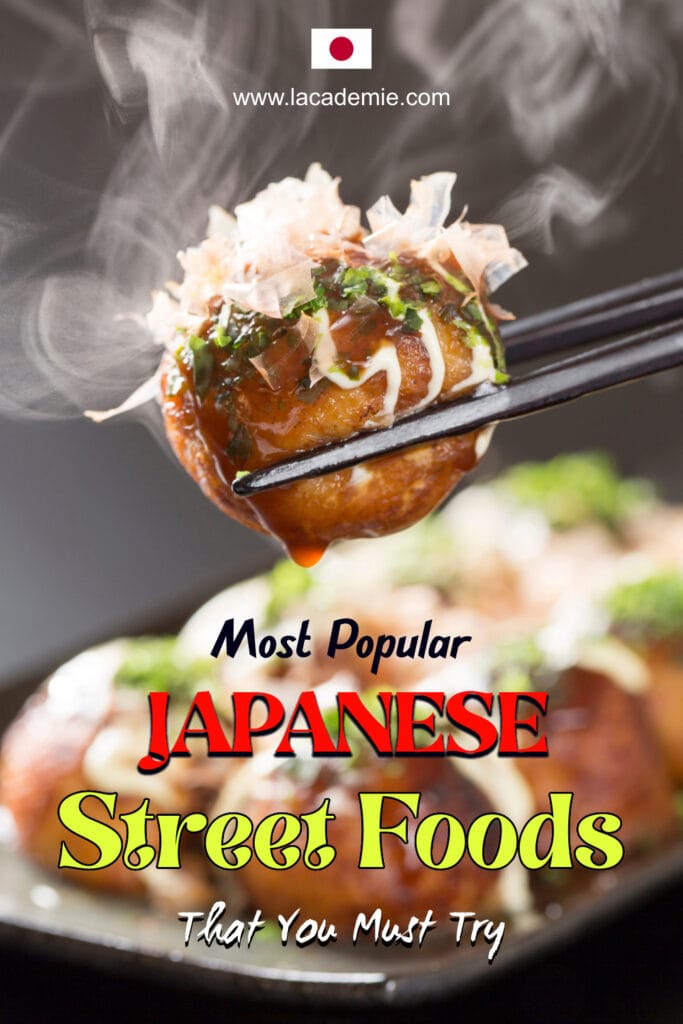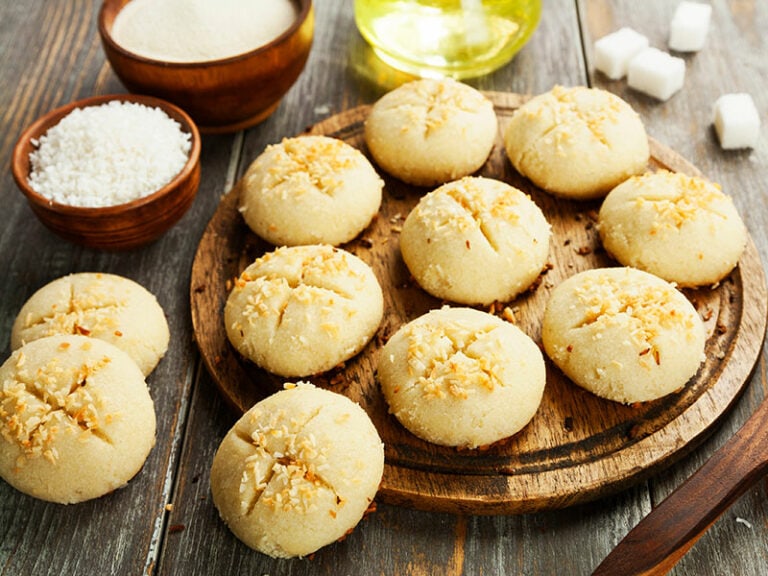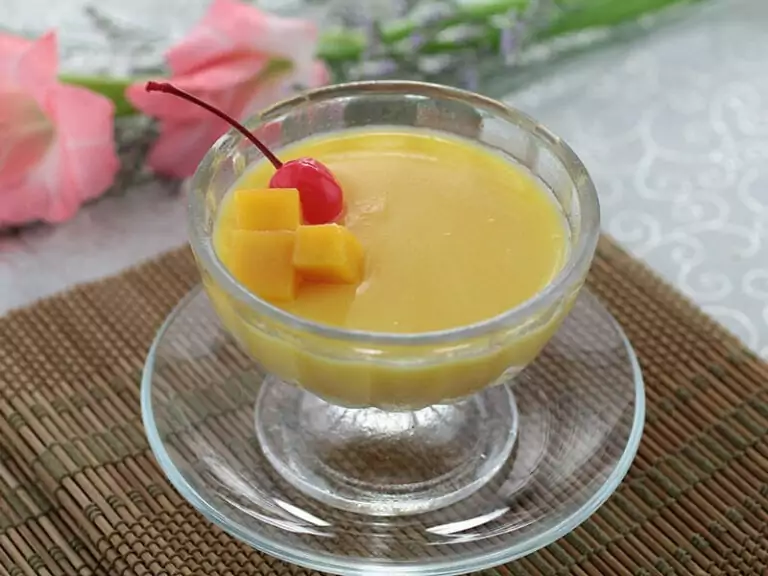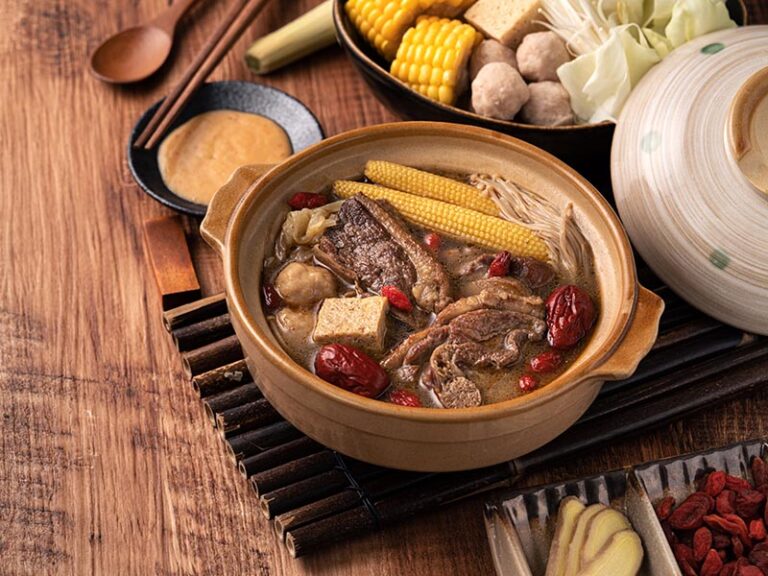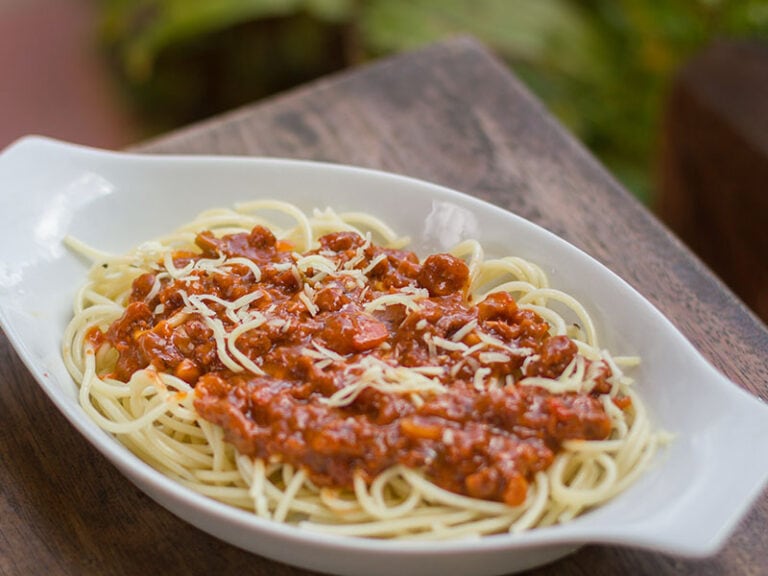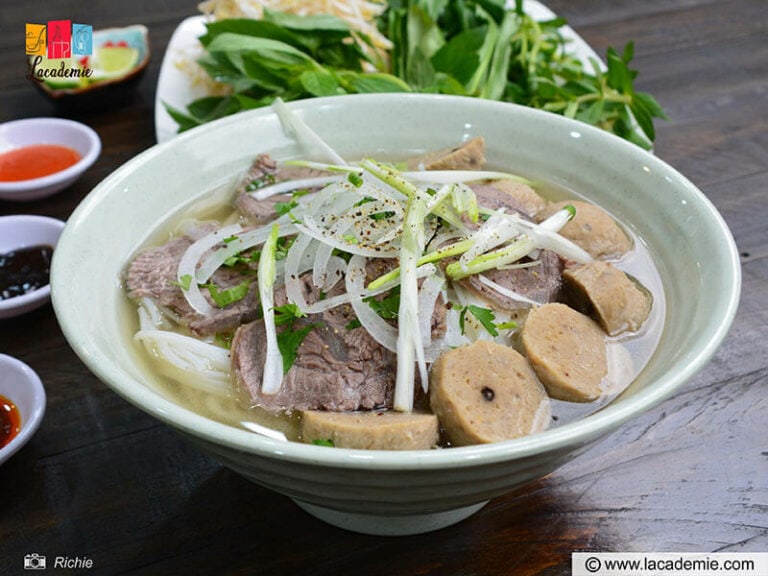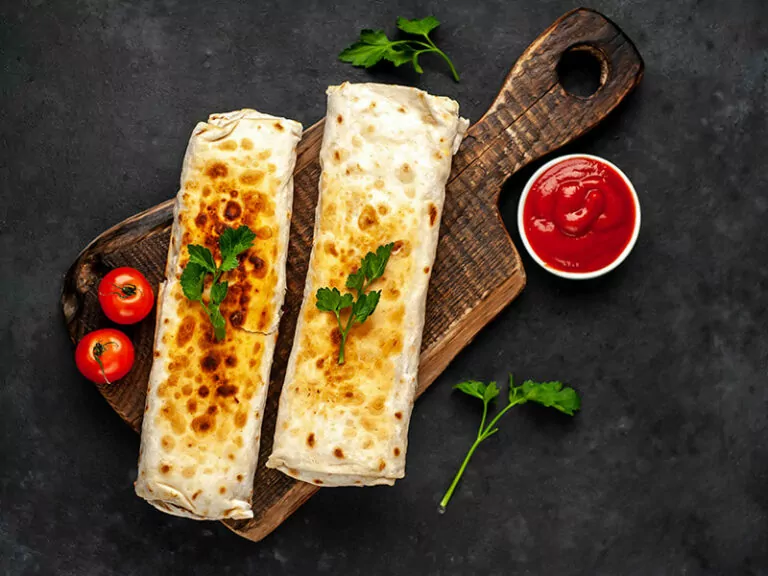What distinguishes Japanese street food from other cuisines? Is it the wide variety of delectable snacks? The skills of the street food vendors? The freshness of the ingredients? The answer is all of them!
Compared to the street food culture of other Asian countries like Thailand or Taiwan, the one in Japan is less prevalent due to the lack of night markets. However, various savory or sweet treats are always ready to be served at numerous festivals (matsuri).
The sheer volume of the fantastic dishes in this country is quite shocking. To be frank, it might take you a lifetime to try out all the typical dishes and their variances in Japan. But in this article, you will give you a hand and highlight the most iconic ones. Read on!

Delicious Street Snacks You Can Get At Japanese Yatai
Japanese street foods are often sold at a Yatai (small, mobile food stall) at traditional summer festivals. Here are some of the best options:
1. Shioyaki – Salt-Grilled Fish
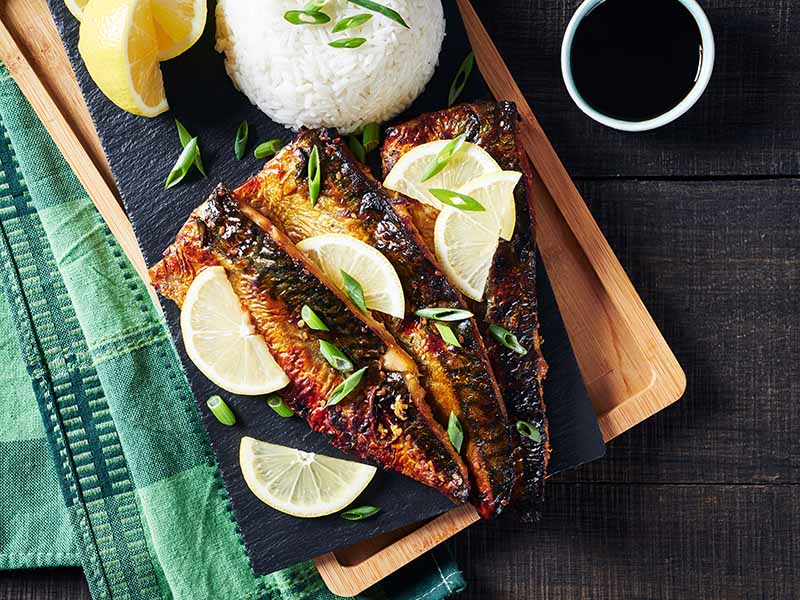
Surrounded by the bountiful oceans with different varieties of seafood, Japanese cuisine has hundreds of modern and traditional fish-based creations. Shioyaki is one of them!
This famous street food item consists of grilled salty fish on a stick. The fish, usually mackerel, is heavily-salted and marinated overnight before being grilled over flames. This dish is quite salty, making it the dish to pair with a jug of icy cold beer.
Although mackerel is the most common choice for Shioyaki, sea bream is also popular. In fact, salt-grilled sea bream, also known as Tai No Shioyaki, is a traditional New Year’s dish in Japan.
If you want to know more about Shioyaki, check out how the locals make them!
2. Takoyaki – Octopus Balls
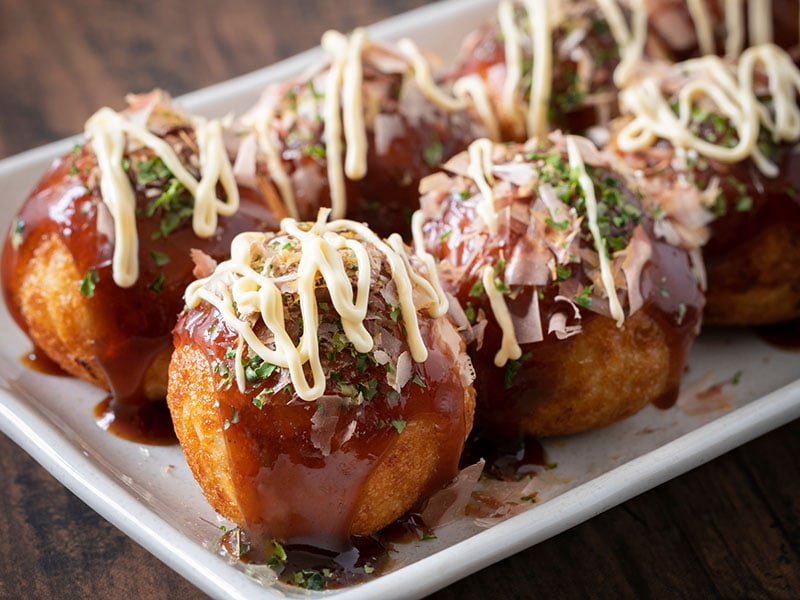
You can easily find this tasty ball-shaped Japanese snack across Asia. This delectable delicacy is a well-known street specialty of Osaka, invented in 1935 by a street vendor called Tomekichi Endo.
Takoyaki took inspiration from Akashiyaki, a tiny spherical dumpling consisting of an egg-rich batter and octopus from Akashi, Hyōgo Prefecture. Takoyaki gained its popularity in the Kansai region of Japan and then moved to the Kanto region and other parts of the country.
This delicious street food contains diced octopus (called Tako in Japanese), pickled ginger, green onion, and tempura scraps. Once cooked, the seafood balls will then be topped with bonito flakes, green laver, mayonnaise, and takoyaki sauce (similar to Worcestershire sauce).
3. Tako Tamago – Octopus Egg
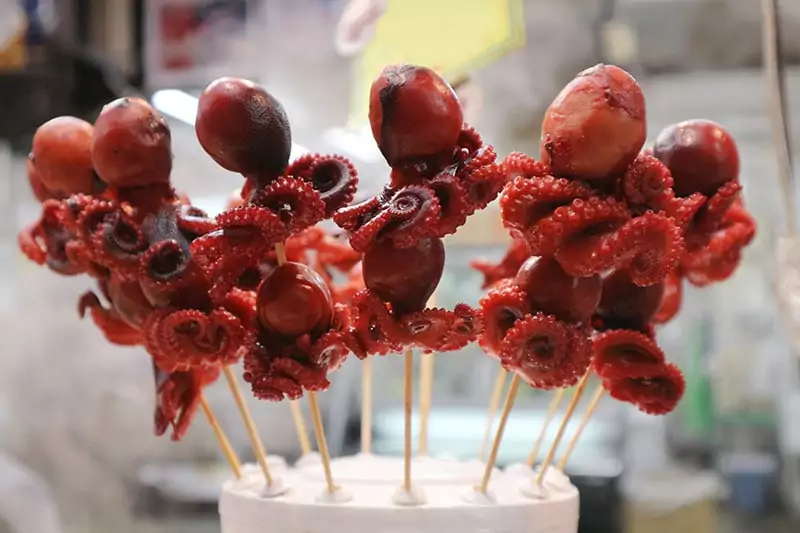
Here is another octopus-based dish that you might like, the Tako Tamago! Tako is the Japanese word for “octopus”, and Tamago means “egg”. The egg here is not an octopus egg; it’s a boiled quail egg stuffed inside red glazed baby octopuses.
Legend has it that Tako Tamago originated in Kyoto’s Nishiki Market. This dish has now become a famous street food snack in Kansai markets.
If you’re in Osaka, you can also find these delicious octopus sticks in Kuromon Ichiba Market, one of the city’s most excellent spots to eat street food.
4. Ikayaki – Grilled Squid
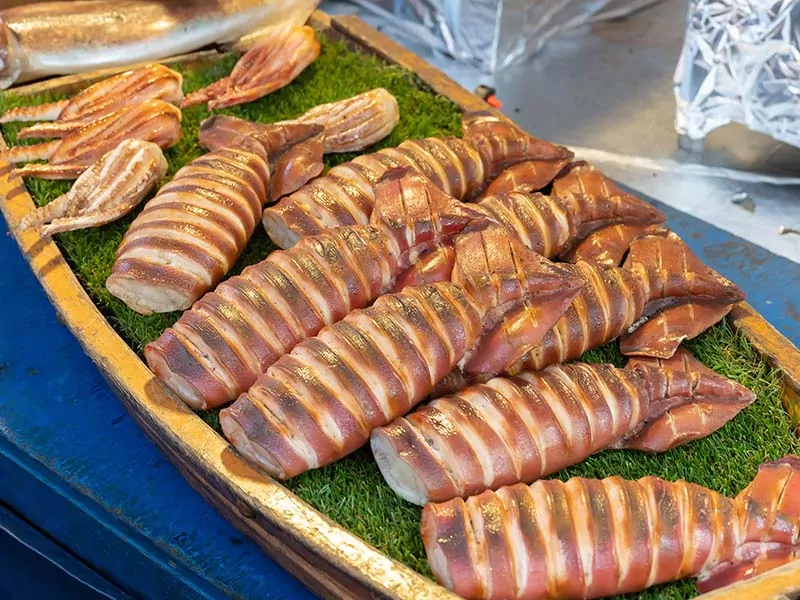
If you prefer squids over octopuses, Ikayaki is the dish for you! The squid is cooked whole over charcoal and brushed with soy sauce, resulting in a meaty, savory meal-on-the-go in minutes. This dish usually comes with soy sauce and a lemon or lime slice.
At restaurants or pubs, the cooks usually serve Ikayaki whole or slice them into rings with tentacles on the side. However, the vendors will serve Ikayaki on a stick at Japanese festivals, so you can enjoy them while walking.
5. Jaga Bata – Butter Potato
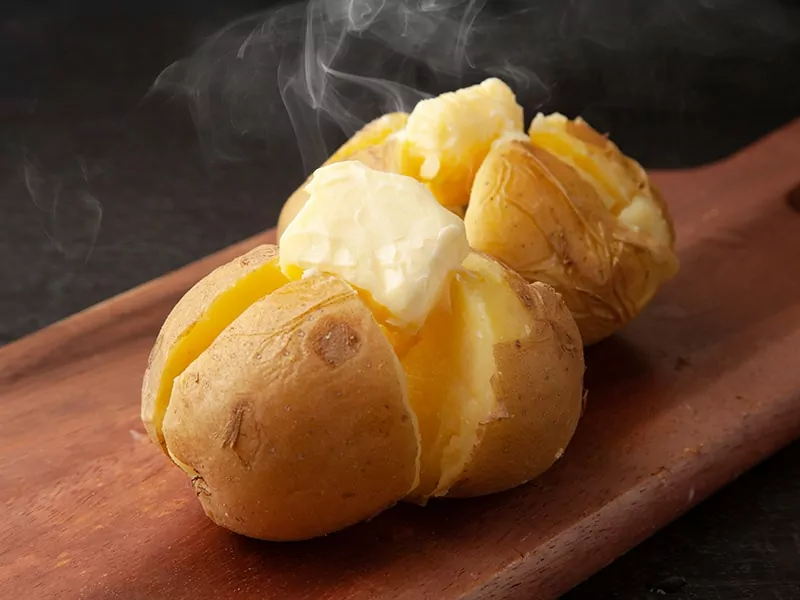
Potatoes are a South American staple, but the Japanese love them just as much as anybody else. With a simple combination of potato and butter, Jaga Bata is a wonderful yet affordable street food option that will fill you up without breaking the bank.
This long-time favorite festival food has a very straightforward name. The Jaga is an abbreviation of Jagaimo, which means “potato”, while the Bata means butter.
Although this is a standard street food option, people also treat it as one of the most popular Asian starters. So grab some delicious Jaga Bata at Yatai street stalls or make them at home during lunch.
6. Yaki Imo – Baked or Roasted Sweet Potatoes
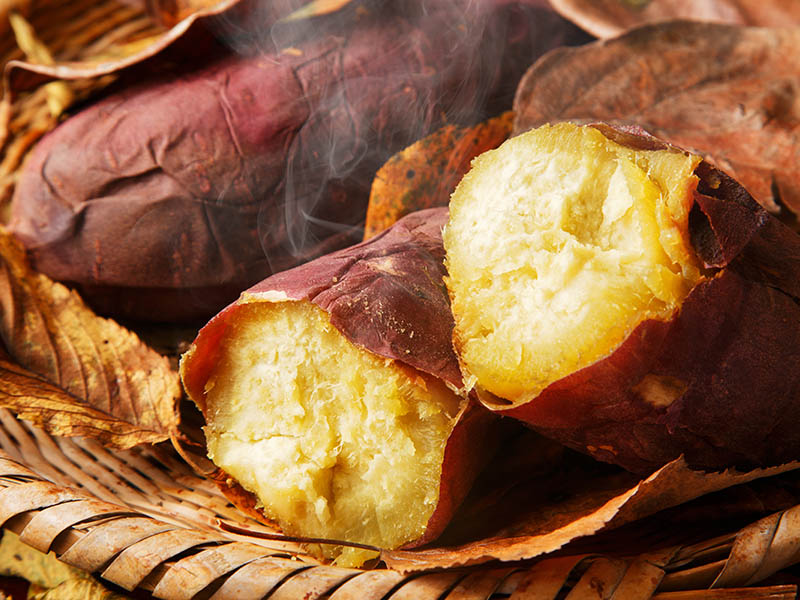
While walking on Japanese streets, the scent of freshly baked sweet potatoes from food vendors will make you drool. These potatoes’ soft, warm texture and candy-like flavor are also mesmerizing, making them the perfect snack when winter comes.
This dish is usually made out of Satsuma potatoes. However, baked Annou and Beni Haruka potatoes are also very popular.
The sellers will start selling Yaki Imo through food trucks as winter sweeps in. They will sing out “Yaki Imooo” continuously to attract buyers on the street, and people will come to have a taste of this sweet delicacy.
Besides Yaki Imo food trucks, many food stalls at local festivals and near supermarkets also sell this treat.
Buying Yaki Imo from food trucks is truly a fantastic experience!
7. Yaki Tomorokoshi – Corn On The Cob
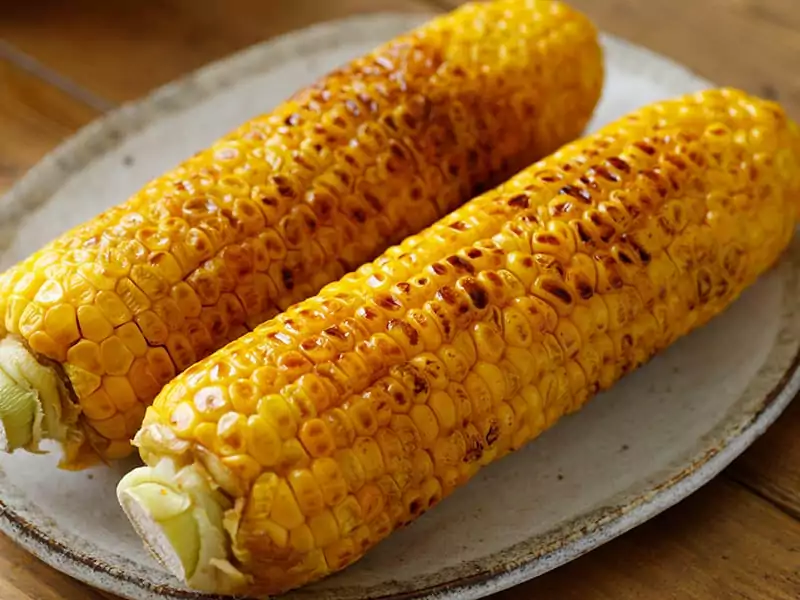
Although most people associate corn on the cob with the iconic street food in Mexico, Yaki Tomorokoshi is surprisingly popular in Japan, particularly among Yatai street sellers and matsuri stalls.
These Japanese corns are grilled with butter, miso, and soy sauce. The vendors serve the corns on a stick to make it easier to eat on the street.
Since they are grilled over charcoal, these delicious corns have an irresistible smoky, barbeque taste. The soy sauce, miso, and butter mixture also help enhance the sweetness of the corn while imparting a salty punch.
This festival food becomes more popular when corn is in season. Most people associate Yaki Tomorokoshi with Hokkaido, where most Japanese corn is grown.
8. Yakisoba – Stir-Fried Noodles
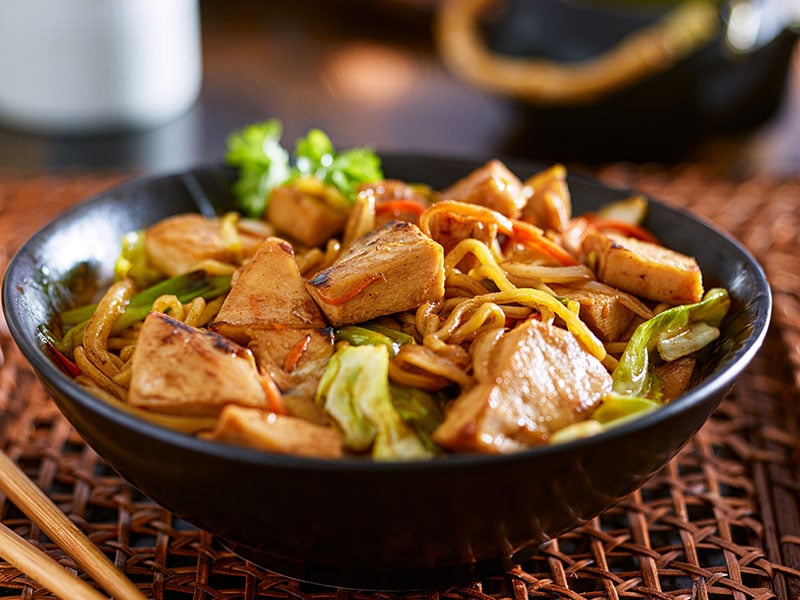
Speaking of Yakisoba, this dish itself is an equally popular and mouthwatering street snack in Japan. The term soba usually refers to buckwheat. However, in Yakisoba, soba refers to Chuuka Soba (a Chinese noodle variety made out of wheat flour).
This dish initially emerged in food stalls during the postwar period in Japan. However, it still maintains its popularity until its very day.
To make a box of Yakisoba, the street vendors often stir fry Chuuka Soba noodles with meat and mixed veggies and serve it with slightly sweet and flavorful Yakisoba sauce. These umami-packed noodles also come with dried bonito flakes and a fried egg on top.
Sometimes, Japanese vendors will serve Yakisoba on a hot dog bun and top it with mayonnaise and pickled ginger. This dish is also known as Yakisoba Pan.
9. Kyuri – Cucumber On A Stick
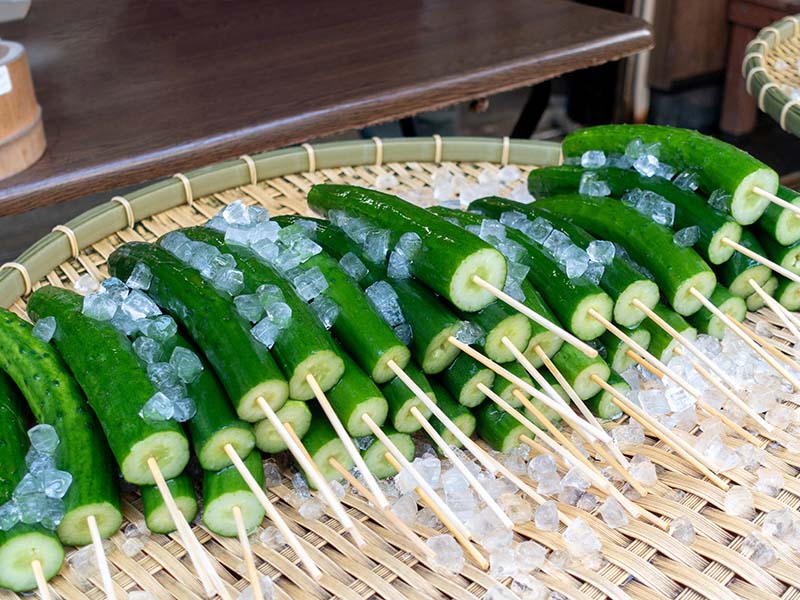
Cucumber on a stick sounds somewhat odd, doesn’t it? However, if you’re looking for a refreshing and healthy snack on the go, Kyuri is a perfect choice!
This dish is typically served ice cold at many festivals and markets. In Japan, people love mixing cucumber with sugar and miso paste to pair it with rice, so Kyuri is basically a street food version.
According to Japanese tradition, cucumber can help you cool down. So this will be an ideal street food snack for hot afternoons.
10. Kakigori – Shaved Ice
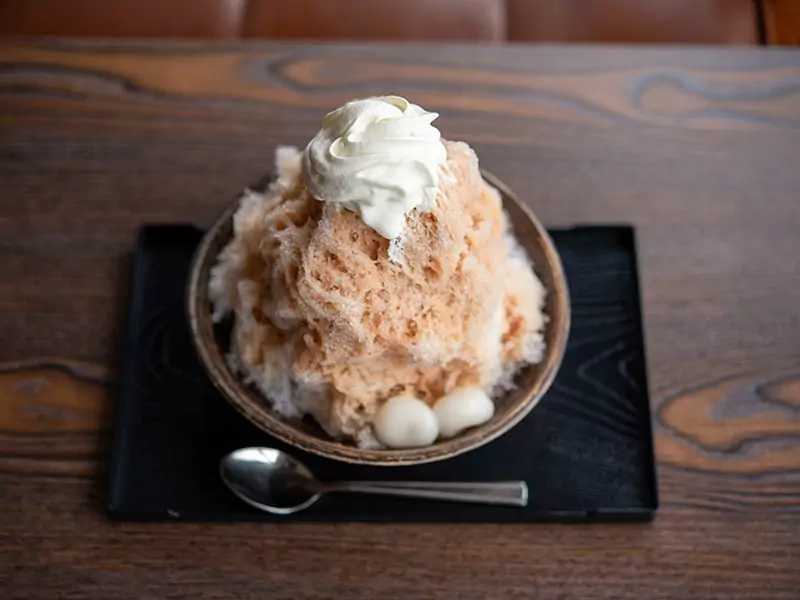
Although Kakigori is comparable to shaved ice in the West, it typically comes in unusual flavors like matcha green tea and lemon. The Japanese shaved ice also comes with mochi balls, whipped cream, and sweet red bean paste. Yes, the Japanese indeed love their bean paste!
Although it might look like snow cones, Japanese shaved ice has a smoother and fluffier texture. This dessert is so well-loved that the locals even dedicated a day for it. Kakigori day is on July 25th since its pronunciation sounds like “summer ice”.
The roots of Kakigori may be traced back to the Heian period. During this time, Japanese nobles would shave blocks of ice stored during the colder months and serve it with sweet syrup in the summer.
As ice became more available to the general population throughout the summer in the 19th century, Kakigori became more accessible. Most people believe that the first Kakigori shop was established in 1869 in Yokohama.
If you really want to get a sense of Japanese culture, go to a Japanese festival in the summer and eat Kakigori while wearing a yukata beneath a sky filled with fireworks. That’s the best way to enjoy this refreshing and filling dessert.
11. Imagawayaki or Obanyaki – Wheel Cake
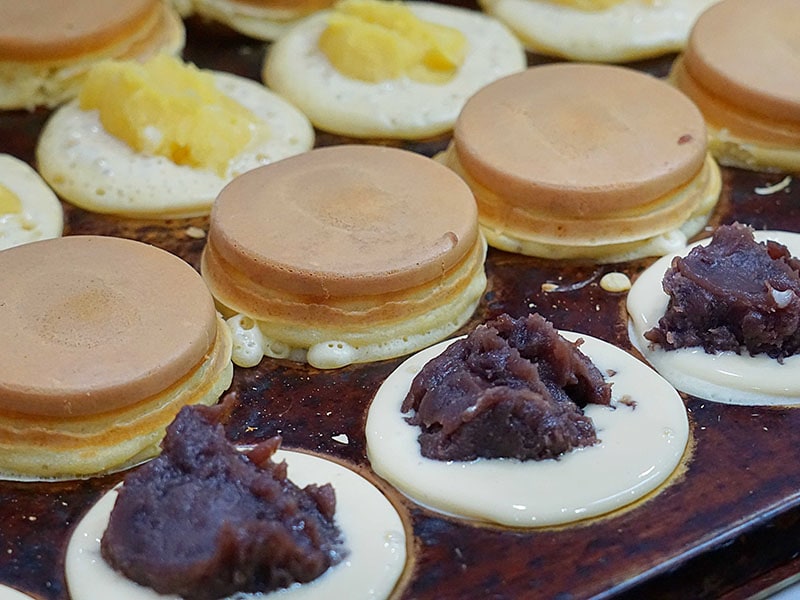
This wheel cake is traditionally made with pancake batter in a special pan filled with sweet azuki bean paste. Various fillings like vanilla custard, matcha, fruit preserves, and meat are gaining attention.
This tasty treat has the name Imagawayaki when first sold near the Kanda’s Imagawabashi Bridge during the Edo period’s An’ei years (1772–1781). Nowadays, it also has different names in different regions, like Kaitenyaki or Obanyaki.
Imagawayaki is now served across Japan under many names and has various ingredients depending on the location. It is also available outside Japan, in places like Taiwan, South Korea, and other Asian countries.
12. Taiyaki – Fish-Shaped Waffle
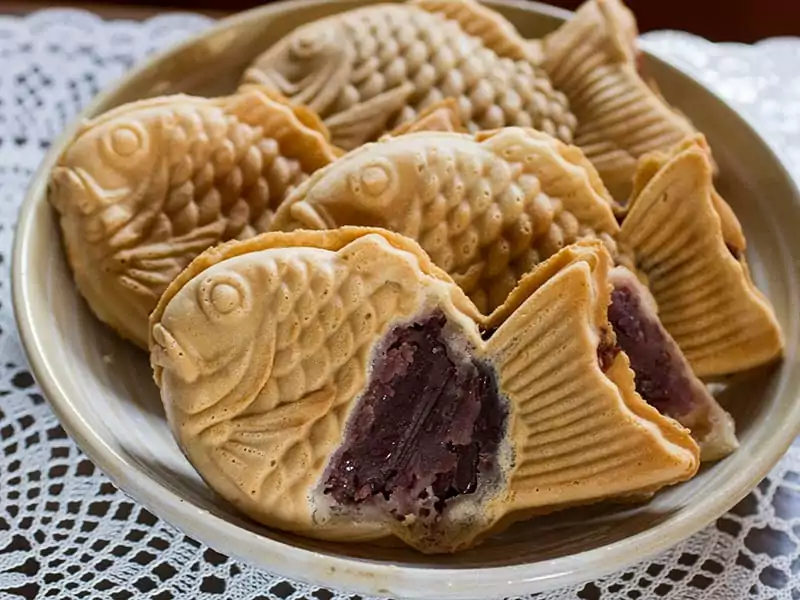
Although this Japanese confection is shaped like a fish, it doesn’t contain any seafood. Instead, it is filled with red bean paste (the most common filling), custard, chocolate, or sweet potato.
The pancake batter and bean paste combination make it taste almost identical to the wheel cake I mentioned earlier. And similar to that dish, the locals also use specifically constructed molds to make this fish-shaped waffle.
In 1909, the first Taiyaki was marketed in Japan as a reshaped version of Imagawayaki. Seijir Kobe, the founder of Naniwaya Sohonten, was having problems selling his Imagawayaki. So, he decided to make them in the shape of a red sea bream (or tai) to make them more appealing.
Since then, his creation has developed into several versions with varied filling and batter components, as well as varying forms and sizes. Taiyaki extended to other Asian nations, as well as the United States, in the postwar period.
Want to see what Taiyaki looks like in Japan? Prepare to be amazed!
13. Choco Banana – Chocolate Covered Bananas
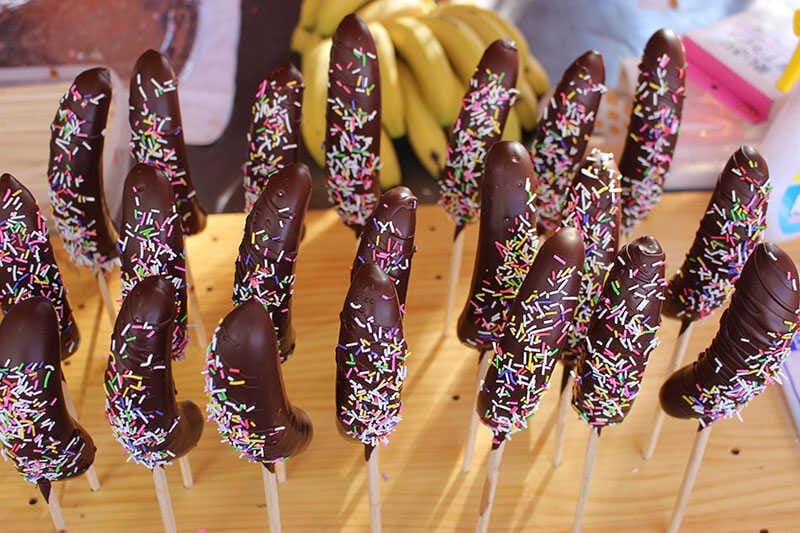
The name of this amusing dessert-style street snack is self-explanatory: a chocolate-coated banana! The combination of chocolate and banana is foolproof, so it is understandable why this street food snack is so popular, especially among the youngsters.
To make this dish, the vendors will dip half a banana (often frozen) in milk, dark, or white chocolate and roll them in colorful sprinkles. This simple yet yummy dessert is also popular in many other countries, the most famous one being the Chocobananos in El Salvador.
14. Wataame – Cotton Candy
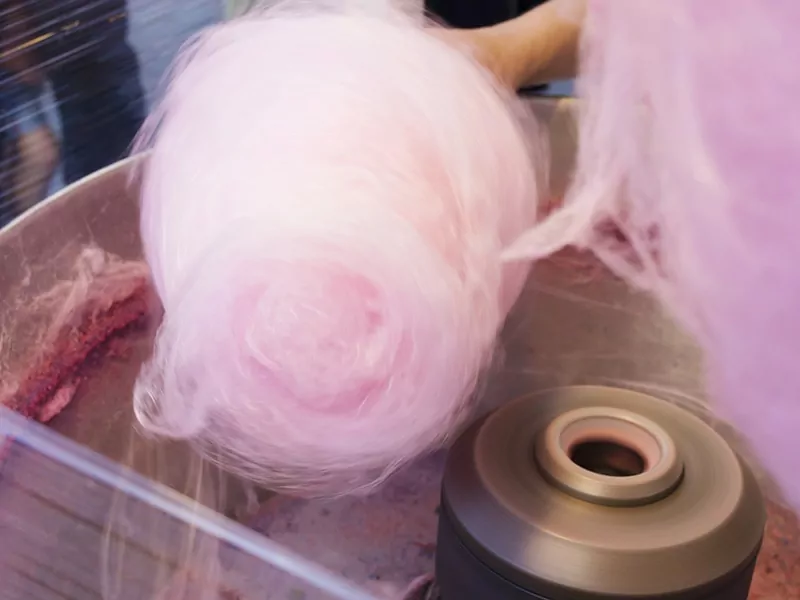
Wataame (also known as Watagashi) is the go-to dessert in Japan if you want to satiate your sweet craving. This sweet treat is a Japanese cotton candy that tastes like sweet, edible fluffy clouds.
Wataame may be found throughout Japan at street food booths and festivals, where you can witness cotton candy being spun around a stick or buy ready-made cotton candy in packages.
As you can probably tell, Wataame is insanely popular among kids. Some cotton candy packages even feature manga characters to attract their attention. But nothing can stop adults from enjoying this dessert too.
Japan even has cotton candy vending machines! Let’s check them out!
15. Candied Fruit
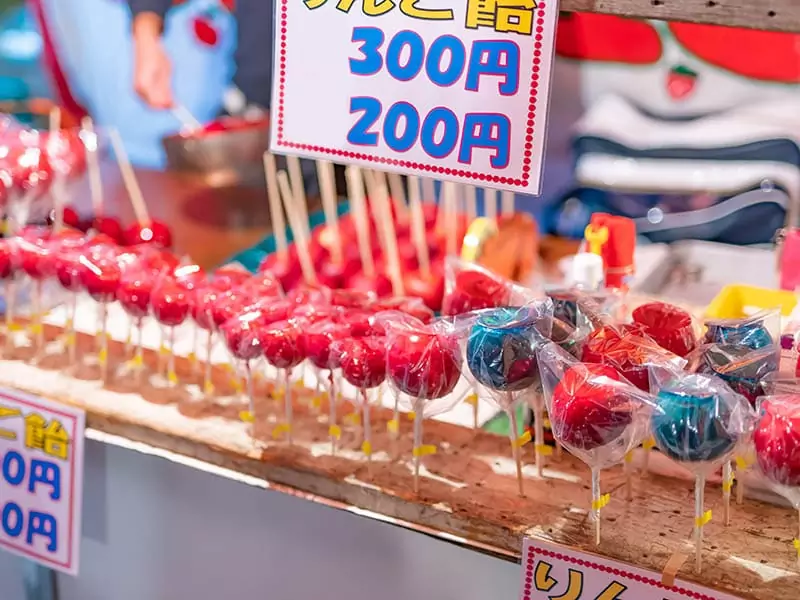
Candied fruit is another popular sweet street food in Japan, and it comes in various flavors. But the most common ones are Ringo Ame (candied apples) and Anzu Ame (candied apricot).
Mikan Ame (candied Japanese mandarin) and Ichigo Ame (candied strawberries) are also famous, but they are only available when these fruits are in season.
These syrup-soaked fruits are attractive to look at and fun to eat. So if you see them, don’t pass up the opportunity to try this Japanese delight!
Go To The Nearest Combini For These Yummy Foods
Whether in Japan or a foreign country, Japanese combini (convenience store) offers tons of delicious meal options. However, even though it is more convenient to grab these dishes at a combini, don’t forget to check out the recommended eateries that I have listed below.
16. Nikuman – Steamed Pork Buns
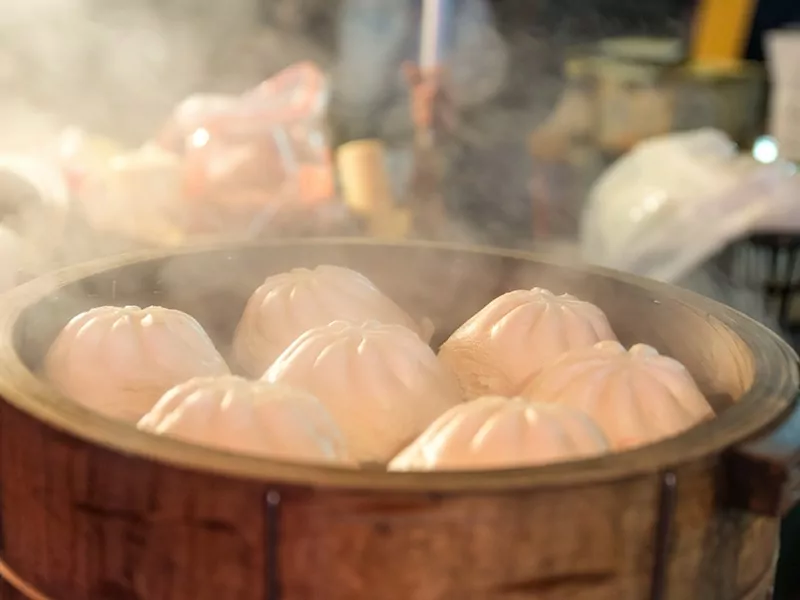
Filled with delicious pork, cabbage, shiitake mushroom, and scallion, these Japanese steamed buns are a fantastic treat to fill your belly anytime. Pork is the most common filling for this dish, but there is a wide range of other flavors that you can explore.
Similar to Gyoza, Nikuman is among the most well-known street specialties in China. However, this savory snack is available at numerous Japanese eateries and convenience stores.
According to Japanese locals, Nikuman tastes best during winter. So if you plan on visiting this country in the cold months, find a Nikuman stand and warm yourself up with a steaming hot pork bun. Besides, hot Nikuman is always available at convenience stores from August to April.
17. Onigiri – Rice Balls
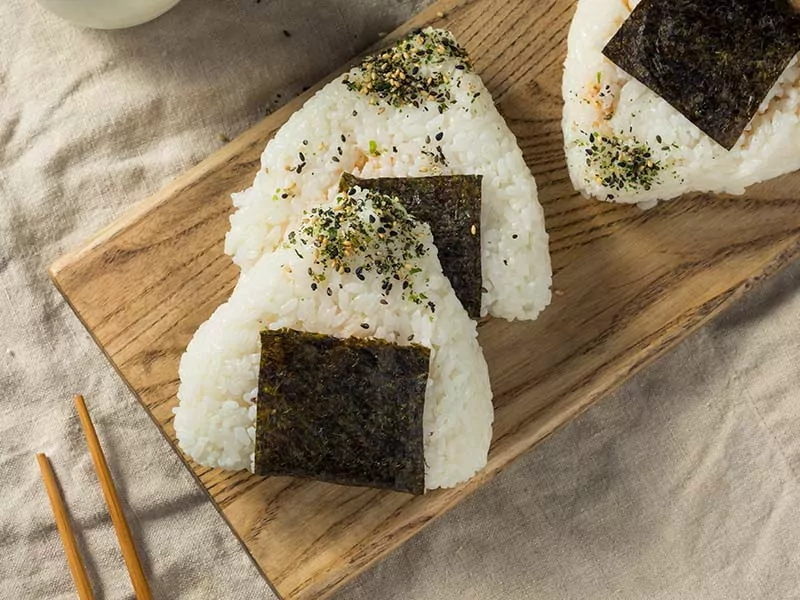
Onigiri is not a kind of Sushi, despite its name and look. While Sushi contains vinegared rice and raw seafood, this dish is prepared with unseasoned white rice, nori, and a filling of some sort.
Seafood, umeboshi (pickled Japanese plum), mentaiko (pollock roe), and kombu (kelp) are some of the most well-known and well-loved Onigiri fillings.
Most of the Onigiri in convenient stores worldwide have a triangular shape. However, this rice dish can also be ball or cylindrical-shaped.
These iconic rice balls have been a convenient and quick meal in Japan from the Kamakura era until the early Edo period. Nowadays, it is a staple in Japanese restaurants across the world, some of which are specialized shops that only sell Onigiri for take-out.
18. Oden – Fish Cake Stew
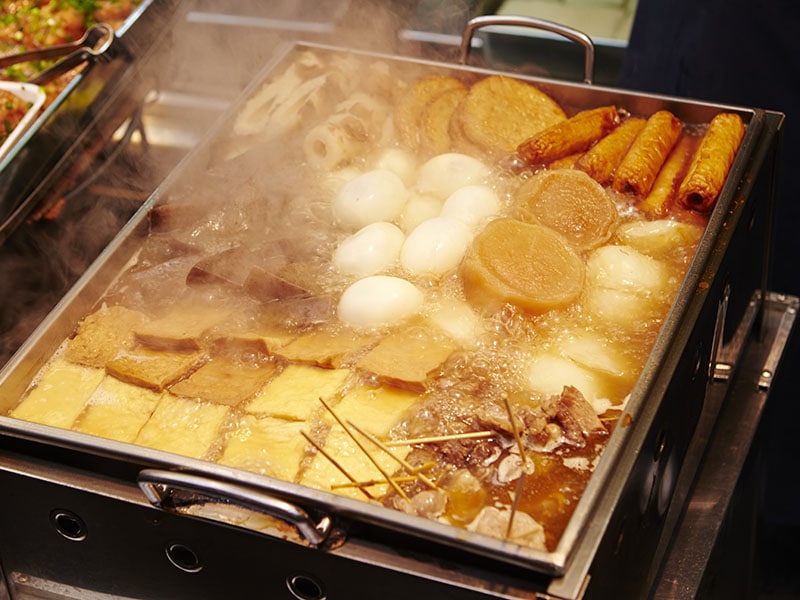
Oden is a winter specialty made up of various types of meat, seafood, and vegetables that have been stewed and served in a mild broth. The warm broth of Oden can instantly warm up your body and your heart, especially on a chilly evening.
The broth is different depending on the region. For example, the one in Tokyo is a bit saltier since the locals like to use dark soya sauce. The Osaka version contains light soy sauce, which is a bit sweeter.
This nabemono (aka one-pot dish) is often sold from food carts year-round. However, you can also find them at Japanese pubs and Oden restaurants. Some convenience store chains, even the ones in America or other countries worldwide, also serve this filling dish.
Check out this old-style stall and learn more about traditional Oden ingredients!
19. Kare Pan or Kashi Pan – Curry Bread

Imagine biting into crunchy bread filled with tasty brown curry; doesn’t that instantly make your mouth water? Unlike Indian curry, the traditional curry in Japan is slightly sweet, which matches well with the sweet fried dough of Kare Pan.
This popular Japanese dish is typically breaded and deep-fried. However, some bakers prefer baking it. Baked or fried, Kare Pan is an irresistible pastry that you can enjoy in any local bakery or convenience store.
This dish is so well-loved among children that there is even a superhero based on this dish. This superhero is called Karepanman, a character in a popular Japanese superhero picture book series.
20. Karaage – Fried Chicken
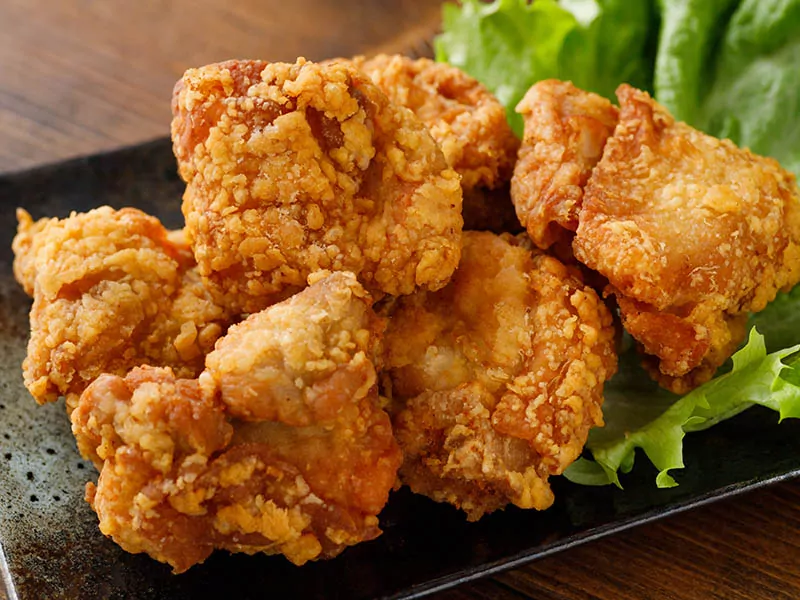
Children or adults, no one can resist fried chicken. That is why Karaage, Japanese deep-fried chicken, has become one of the most awaited dishes for both foreign visitors and Japanese locals. Karaage may be found at every convenience store, supermarket, and pub.
Chicken dishes have always been a staple in Asian cuisine, but the Karaage cooking method makes the chicken quicker to prepare and gives it a new flavor profile. The technique gained popularity due to post-World War II food shortages in Japan, particularly for chicken.
The Toyoken restaurant in Beppu was the first place to popularize Karaage in the 1920s. From that point on, this signature Japanese chicken treat continues to be a national favorite. There is even an annual Karaage Festival in Japan where 60 shops participate in making unique versions of this dish.
Due to its popularity, Karaage has lots of different regional variations, such as Zangi in Hokkaido, Tebasaki in Nagoya or Toriten in Oita.
21. Korokke – Potato Croquette
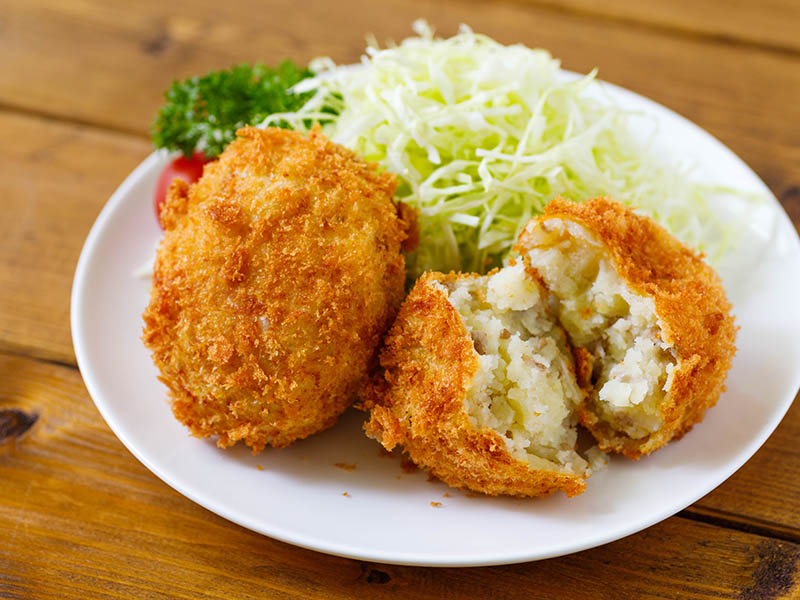
In 1887, the classic French croquette made its way to Japan. This dish eventually became a staple in this country’s cuisine due to its incredible flavor and low price. This easy-to-eat Japanese ground beef treat is available at practically any supermarket and convenience store.
The locals combine various chopped meat, fish, or vegetables with mashed potatoes to make Japan’s Korokke. The meat and potato balls are then coated in a layer of wheat flour, eggs, and panko breadcrumbs and deep-fried till golden brown.
22. Melonpan – Melon-Shaped Bread
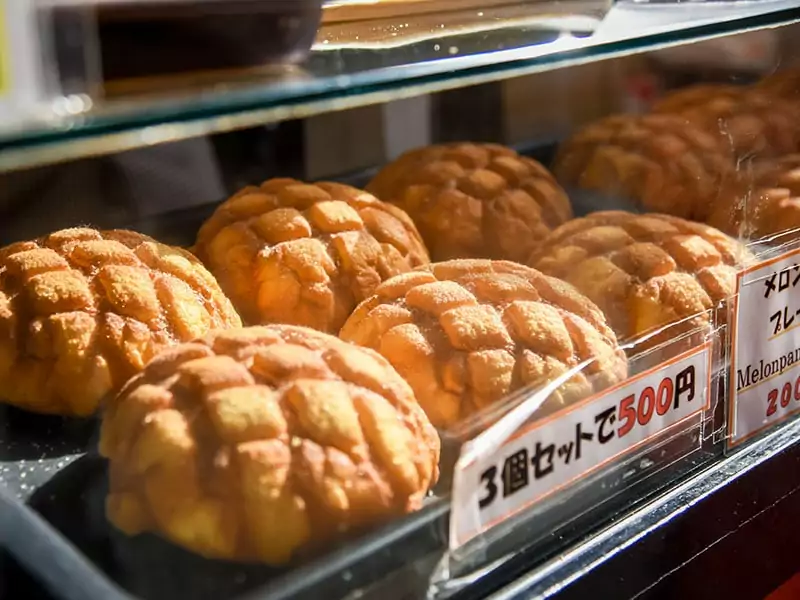
Melonpan is a sweet Japanese bread made with sweetened dough and a layer of cookie dough on top. The cookie dough top gives it a firm and crunchy crust that everyone loves.
Although it is called “Melonpan”, this bread didn’t contain melon until recent years. It gets its name from the crispy top crust with a criss-cross design that looks like a melon rind, considered a luxurious fruit in Japan throughout the 20th century.
Ivan Sagoyan, an Armenian baker, invented this iconic bread while working at the Imperial Hotel in Tokyo. Despite its long history, it is still one of Japan’s most beloved bread types and other Asian countries like Taiwan or China.
23. Soft Cream
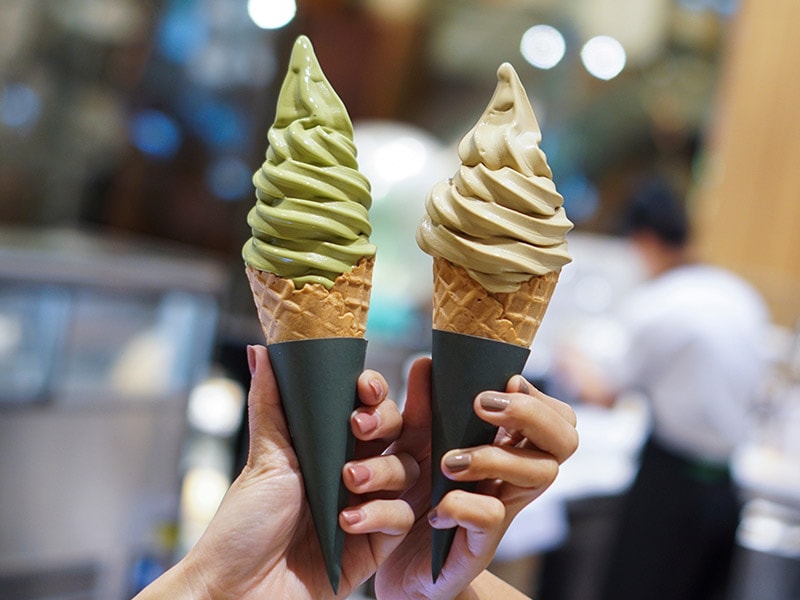
Nothing is more refreshing than soft-serve ice cream on a hot summer day. In this country, eating Soft Cream is viewed as a form of gentle communication.
The Japanese Soft Cream is creamier and thicker than the typical soft serve and is available at festivals, marketplaces, and convenience stores around Japan.
This dessert tastes terrific in any Japanese region, but the Soft Cream in Hokkaido is truly exceptional. So if you’re planning a vacation to Sapporo, Soft Cream (and other Hokkaido milk products) is an absolute must-try.
Grab Your Favourite Street Foods At The Local Restaurant
Don’t miss out on these delicious, filling meals at the local Japanese restaurants! Due to the popularity of these street snacks, there are many eateries in Japan dedicated to them and only them. So note down the locations below and hop on a Shinkansen now!
24. Ramen
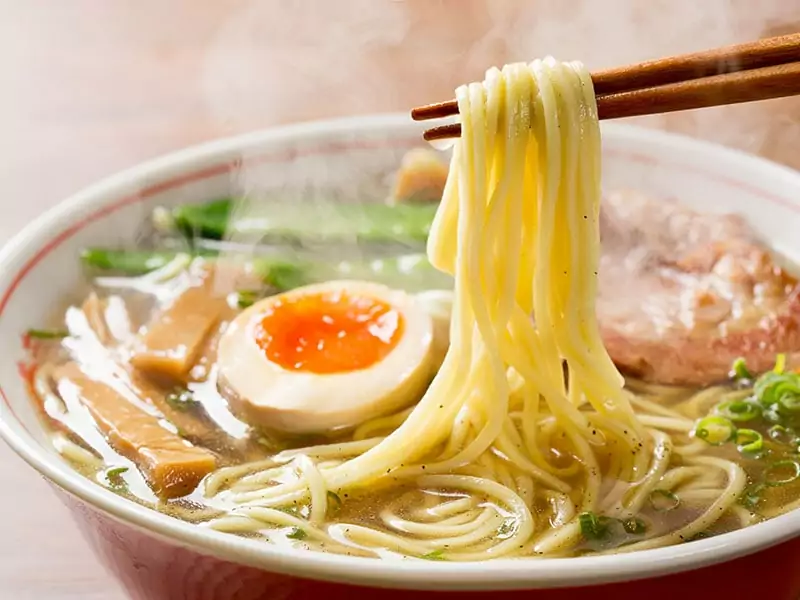
Nothing can be better than Ramen when it comes to iconic Japanese dishes! This irresistible noodle soup comprises Chinese wheat noodles in a meat or fish-based broth with toppings like sliced pork, nori, scallions, and soy sauce or miso.
Ramen has countless regional variations, some of which have become national prominence. All these variations are unique and delicious in their own ways, so you should definitely try them all during your visit and find the one that suits your preference the most.
This Japanese delicacy has a unique variation in almost every region; the most notable ones include Tonkatsu Ramen in Kyushu and Miso Ramen in Hokkaido.
Some Ramen eateries only have 1 counter and 1 chef; these places usually have a ticket machine so customers can pay for their meals in advance.
25. Okonomiyaki – Savory Pancakes
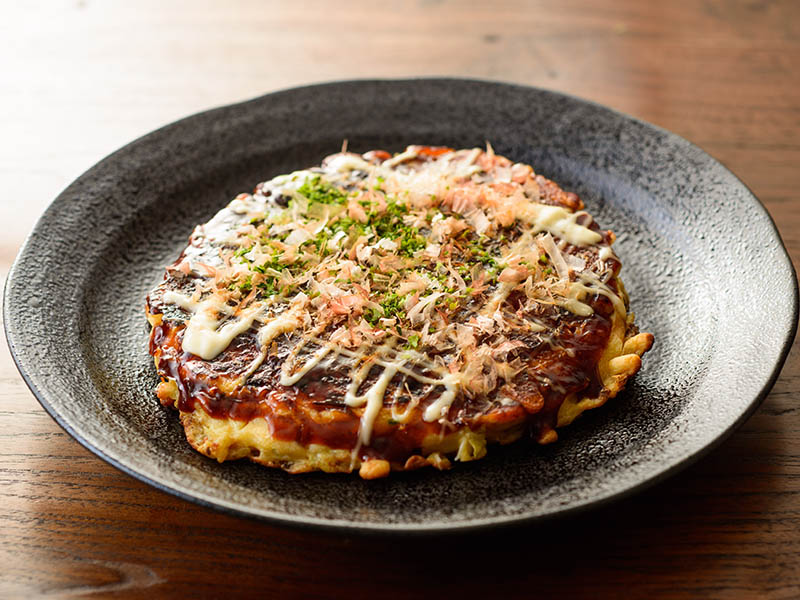
Okonomiyaki is a savory pancake filled with cabbage, meat, seafood, egg, and noodles. It also includes several toppings like seaweed flakes, bonito flakes, Japanese mayonnaise, and okonomiyaki sauce (made with Worcestershire sauce).
The name of this legendary dish is derived from the word okonomi (meaning “how you like”) and yaki (which means “cooked”).
Although this dish is known to be a specialty of Osaka, Hiroshima-style Okonomiyaki became a massive hit with the locals and foreign visitors. This version truly stands out with its unique addition of Yakisoba noodles and fried eggs.
Hungry for some Okonomiyaki? Take a look at this!
26. Yakitori – Skewered Chicken
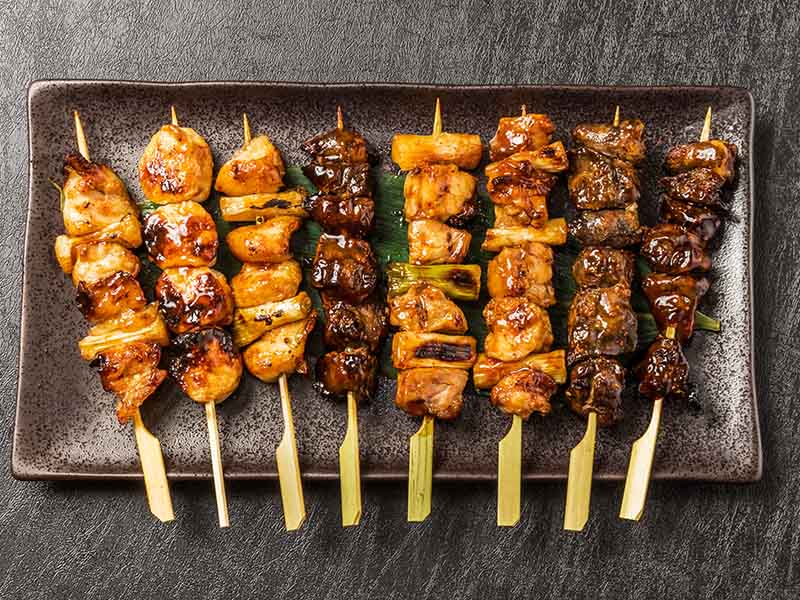
Yakitori, which means “grilled bird”, is one of Japan’s most famous street foods. These charcoal-grilled chicken skewers are so simple to eat, but it takes Japanese cooks years of practice to master this dish.
This delicious street food is usually available at food court areas, sports matches, Japanese pubs, and high-end restaurants. At certain high-end places, the chefs even seek out rare chicken breeds for their distinct flavor and texture.
There are many variations of Yakitori, but the most popular ones are Negima Yakitori (chicken thigh and green onions) and Tsukune (chicken mince). The Japanese cooks usually season Yakitori with soy grilling sauce and salt; sometimes, they add sour plum paste and wasabi.
Despite being called “grilled bird”, these skewers can also be made of grilled beef, pork, and veggies.
This Yakitori master will tell you everything about enjoying Yakitori!
27. Gyoza – Dumplings
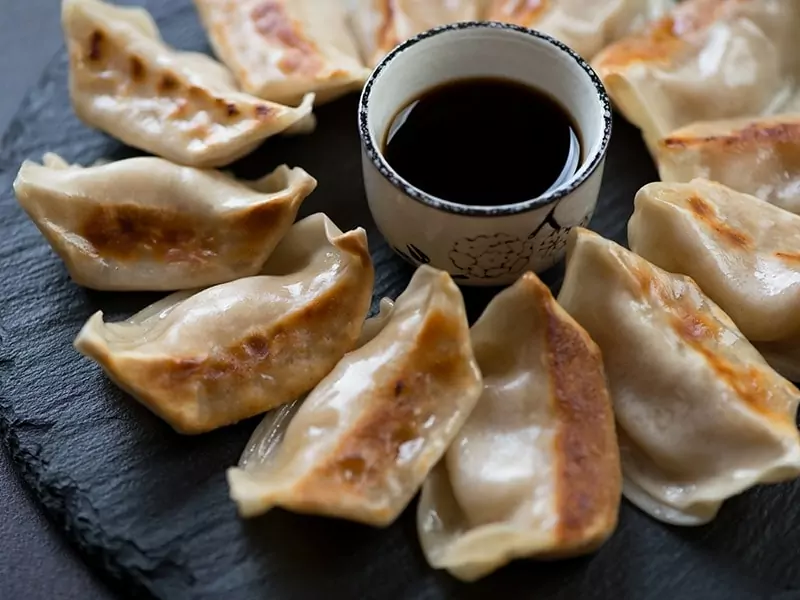
Despite its origin in China, Gyoza is insanely popular in Japan. These yummy dumplings contain ground pork, chives, cabbage, soy sauce, and garlic ginger.
Compared to Chinese-style dumplings (or jiaozi), the Japanese version has a richer garlic flavor and thinner wrappers.
The locals often pan-fried their Gyoza on one flat side to create a crispy skin. When the upper half of the dumpling is steamed, they will pour water into the pan and secure it with a lid. The dumplings are customarily served in groups of six with a soy sauce and vinegar dipping sauce.
28. Japanese Crepes
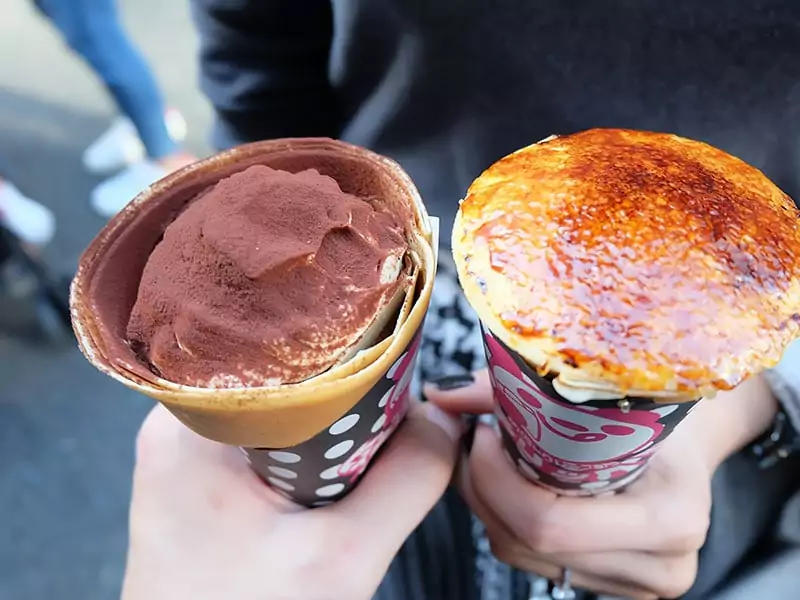
Crepe is a well-known dessert that originated in France during the 13th century and is now enjoyed in many countries worldwide. And this, of course, includes Japan.
The locals love to modify this Japanese Crepe in various recipes with fillings like chocolate, fruit, whipped cream, and ice cream. They are not served on a plate like the French Crepes. Instead, they are folded into a cone and wrapped in a paper case.
People often add different flavors to their Crepes, depending on the seasons. Cherry blossom flavorings are common during spring, while pumpkin and sweet potatoes are preferred in autumn.
This colorful dessert is an iconic treat on Tokyo streets, especially in the buzzling Harajuku district. You can buy this treat at the food trucks on Harajuku street or in Japanese Yatai. Some malls in Japan also offer this popular street food snack.
29. Kare Raisu – Curry Rice
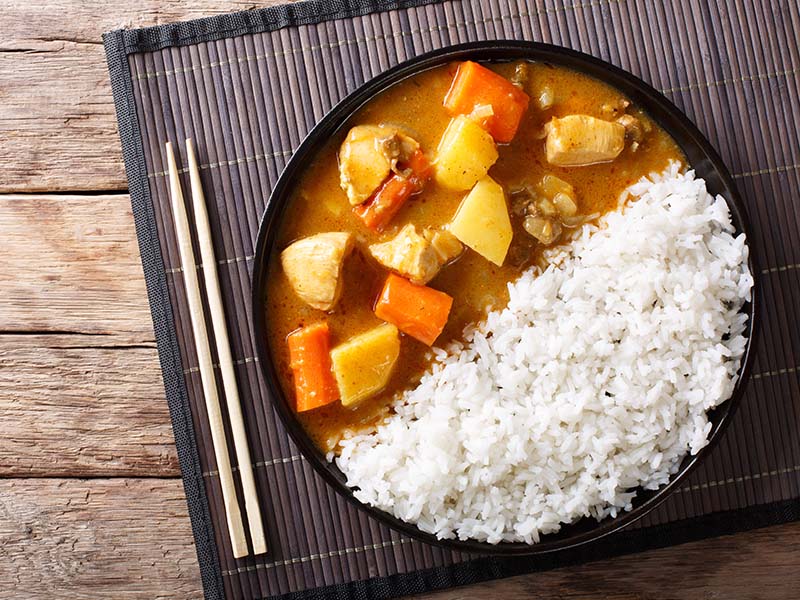
Similar to the curry in Kare Pan, this Japanese “Kare” is a little milder than typical Indian curry. This signature recipe in every Japanese meal is not only filling but also nutritious and delicious.
Japanese curry contains a wide range of vegetables, meats, and sweet and savory sauces. Onions, carrots, and potatoes are the most common veggies, while pork, beef, and chicken are the most popular meats.
Curry originated in Indian cuisine and was brought to Japan by the British from India. In the late 1960s, Kare Raisu grew popular and was available in nearly every store and restaurant. The curry has been changed to suit Japanese tastes since its inception.
30. Senbei – Rice Crackers
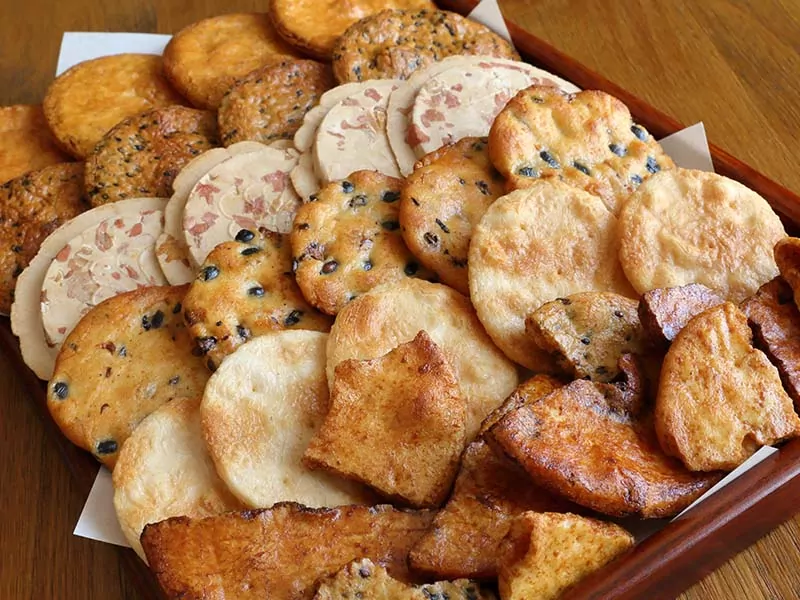
Senbei is a hugely popular rice-based snack with various flavors, usually savory but sometimes sweet. There are several regional varieties, and the ones sold by street food sellers in Yatai are generally grilled over a charcoal barbecue.
The rice crackers in Yatai are usually sprayed with a glaze consisting of mirin and soy sauce. The locals will also pair them with nori, red chili pepper, and black sesame.
This traditional crunchy snack has many variations across Japan. Some are baked, some are deep-fried; some use rice, some contain wheat flour or starch. The locals also put fish or different veggies to add more flavor.
Senbei can be served with green tea as a light snack and courtesy refreshment to visiting house guests.
Here is how the Japanese vendors prepare Senbai for their guests!
31. Dango – Rice Dumplings
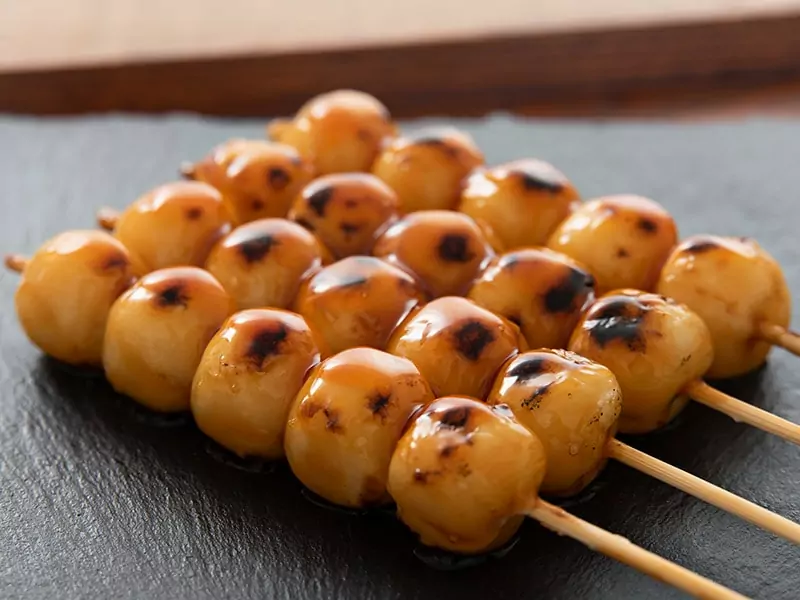
Made out of uruchi rice flour and glutinous rice flour, these adorable rice dumpling skewers are extremely popular at festival food stands or outside Shinto temples. During Cherry Blossom season, the locals also love to enjoy Dango at the get-togethers.
There are various types of Dango in Japan, either colorful or plain white, sweet or savory. Among them, Mitarashi Dango is the most popular variety, which comes with a sweet and salty soy sauce glaze. This variation is well-loved because of the contrasting flavors and textures.
During cherry blossom season, Hanami Dango starts to make its appearance. These lovely pink, green, and white-colored rice balls perfectly resemble the Japanese unofficial national flowers, making it the ideal treat for a hanami picnic.
Sometimes Dango is paired with sweetened red bean paste and roasted soybean flour. Matcha or sakura-flavored Dango are also worth trying.
32. Shu Cream – Cream Puff

“Shu Cream” is how the Japanese refer to the French choux pastry puffs with sweet custard cream that everyone adores.
While the conventional Shu Cream comprises a basic puff pastry shell and a typical yellow custard cream center, some Japanese variations incorporate a substantial coating of dark chocolate. Chocolate, matcha, strawberry cream fillings are also common here.
Despite their French origin, these crunchy yet soft puffs have become a culinary staple that many generations of Japanese children have grown up enjoying. They may be found in many places, from high-end patisseries to vending machines.
Japan even has the worldwide famous Shu Cream chain called Bread Papa. In Japan, you can usually find this shop at metro stations.
Experience Japanese Street Food Culture Like A Local!
Street food has always been a massive part of the cuisine from all around the world. Although street food stalls were previously on a decline in Japan, this concept has officially made a comeback in these recent years.
Besides wandering the streets of big cities in Japan, be sure to check out the Yatai or street food vendors. Not only will you be able to try out different street foods in one go, but you can also learn about Japanese culture and enjoy fun festival activities.
Thank you so much, everyone, for reading! Don’t forget to give this article a like and leave a comment down below about your favorite street food snack. Also, if you know someone who loves Japanese cuisine and culture, send them this post and help them learn more.
